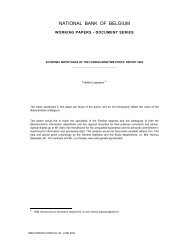Working Paper Research - Nationale Bank van België
Working Paper Research - Nationale Bank van België
Working Paper Research - Nationale Bank van België
You also want an ePaper? Increase the reach of your titles
YUMPU automatically turns print PDFs into web optimized ePapers that Google loves.
accounts. Dupriez's theoretical approach was greatly inspired by Walrasian general equilibriumtheory, very much like Austrian business cycle theory 7 . In his view, it was crucial that economictheory should go back to individual economic decisions.Lamfalussy became Dupriez's assistant for business cycle analysis and also attended the monthlymeetings of the Institute with industrialists. However, Lamfalussy took more "Keynesian" positionsthan Dupriez (Maes, 2009) 8 . While Dupriez disliked formal model-building, Lamfalussy saw this asa way to make explicit the implicit model which one was using anyway 9 . Lamfalussy was alsostrongly in favour of government intervention and planning, including a selective government policyto stimulate investment in new industries, something which Dupriez abhorred (see the discussion inDupriez, 1961). However, Dupriez's approach of basing economic analysis on empirical materialand his contacts with industrialists were important elements in the formation of Lamfalussy. Basingeconomic analysis on extensive empirical investigations would become a hallmark of Lamfalussy'sstyle of economics. Moreover, through time, Lamfalussy became more and more positive aboutDupriez, acknowledging that Dupriez understood that cycles should be moderated, but notsuppressed, "Le rêve d'une économie sans conjoncture est aussi «idéaliste» que celui d'unesociété politique universelle sans heurts et s'inscrit donc dans la lignée des utopies" 10 (Dupriez,1959, p. XIII).As Lamfalussy still only had a refugee passport, he could not go to the United States for graduatestudies. Thanks to Dupriez's contacts, he went to Oxford for his doctorate. The theme wasinvestment and growth in post-war Belgium, with Philip Andrews as supervisor and Sir John Hicksas the main examiner. Later, in the academic year 1961-1962, under the influence of Robert Triffin,Lamfalussy went to Yale University. It gave him an American experience as well as an opportunityto delve deeper into the topic of Europe's post-war growth performance 11 .So, in his early academic work, Lamfalussy focused on growth and investment theory andBelgium's and Europe's growth patterns in the post-war period. At that time, Lamfalussy, like manyothers, was intrigued by the issue of the reconciliation of macro- and microeconomics (especiallyimperfect competition theory). For Lamfalussy, this preoccupation was strongly pragmatic. He hadseen that other countries were developing new industries, which were notoriously absent in7 In the post-war period, Keynesian economics gained ground only very slowly in Belgium and Italy, mainlydue to a strong position of Austrian business cycle theory (Maes, 2008).8 Partly under the influence of three other professors (Rousseaux, Woitrin and Urbain), who, compared toDupriez, were more in favour of government intervention and model-building.9 Later, Lamfalussy (1985a, p. 412) remarked about Schumpeter's growth theory: "When I read his writings,more years ago than I care to remember, I hardly understood what he had in mind and dismissed itanyhow because I could not convert it into equations".10 "The dream of an economy with no business cycle is as 'idealistic' as that of a conflict-free universalpolitical society and therefore falls within utopian tradition."11 He also met James Tobin, who was already more critical about the functioning of the financial system.5
















